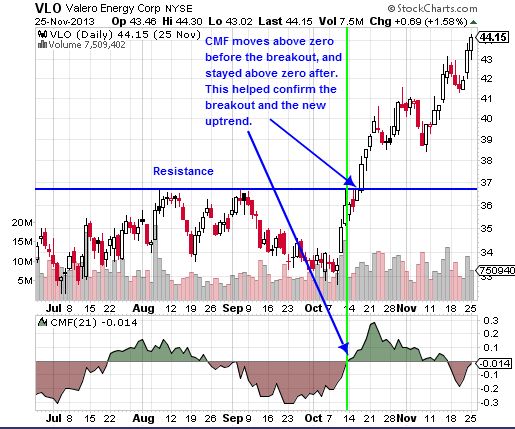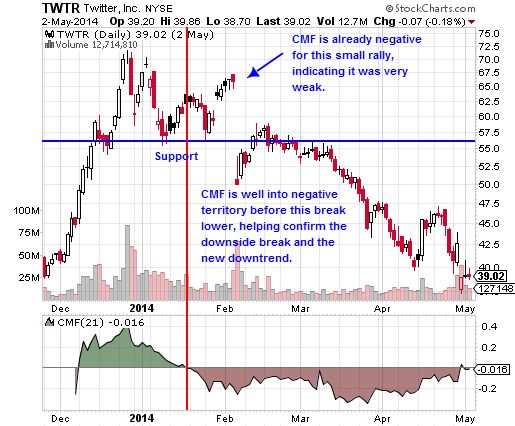Using Chaikin Money Flow (CMF) For Stock Trading
Chaikin Money Flow was developed by Marc Chaikin and is a primary used a confirmation tool for trend trading in stocks. It combines both price action and volume into one indicator, as the founder believes that volume leads price.
CMF moves above and below zero based on whether, on average, the stock is finishing in the upper portion of the daily range or the lower portion respectively. Each day is multiplied by volume, so a down day accompanied by big volume will result in a lower indicator reading than a down day on small volume.
While the indicator is typically used on daily charts, it can also be used on intraday charts where volume data is present. A 21-period indicator is commonly used, because it represents approximately 1 month worth of trading days. Multiples of this number are also used, such as 42, 63, 84, 126 or 252. For short-term trading a fewer number of periods will be favorable since the indicator will react quicker to trend changes. Longer-term traders will prefer a longer period CMF indicator.
One of the main ways to use Chaikin Money Flow is to confirm breakouts.
Isolate a resistance/support area where the price has had trouble getting above/below it on a number of attempts. Mark these areas as resistance or support.
When the price rallies through resistance, look for the CMF to confirm the breakout. CMF should be above zero. If it isn’t, it warns the breakout could likely fail.
When the price falls through support, look for the CMF to be below zero to confirm the breakout. If the price breaks support but the CMF isn’t below zero, the breakout is likely to fail.
Figure 1 shows an example on a daily stock chart. The price was hitting resistance just below $37, which it couldn’t get above on multiple attempts. Then, in October, first the CMF turned positive and then the price broke above resistance. Since the CMF was still positive it confirmed the breakout.

For those looking to go long (buy calls), the CMF could have helped solidify that decision.
Figure 2 below shows how the indicator confirmed a downside breakout.

The stock had found support on a number of attempts just above $55. The CMF turned and stayed below zero even while the price rallied a bit, before eventually gapping below support. The negative CMF reading showed the uptrend was weak, and confirmed the downside breakout. That the CMF stayed below zero following the breakout also helped confirm the new downtrend.
For traders looking to go short the CMF would have given them confidence in their decision.
Final Word
The Chainkin Money Flow is a tool that uses both price and volume to confirm the trend or warn of weakness. It isn’t usually used to provide trade signals itself, rather it simply helps to confirm signals using other strategies, such as breakouts or trend trades. For long trades the CMF should be above zero, and for short trades the CMF should be below zero. This shows that momentum (price) and power (volume) are both moving in the same direction as the trade.
No indicator is perfect though. Always manage position size so that a single losing trade doesn’t significantly draw down your account